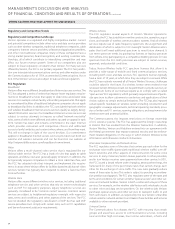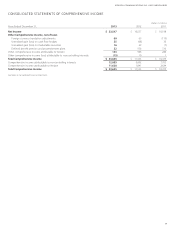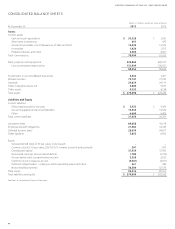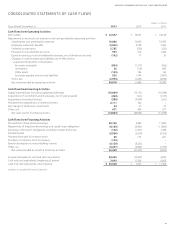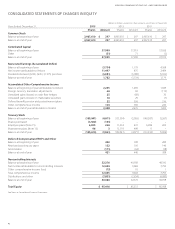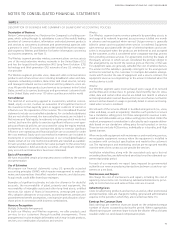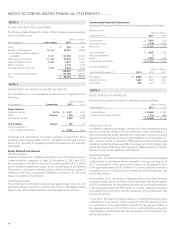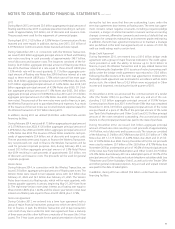Verizon Wireless 2013 Annual Report Download - page 45
Download and view the complete annual report
Please find page 45 of the 2013 Verizon Wireless annual report below. You can navigate through the pages in the report by either clicking on the pages listed below, or by using the keyword search tool below to find specific information within the annual report.
43
NOTES TO CONSOLIDATED FINANCIAL STATEMENTS
NOTE 1
DESCRIPTION OF BUSINESS AND SUMMARY OF SIGNIFICANT ACCOUNTING POLICIES
Wireless
Our Wireless segment earns revenue primarily by providing access to
and usage of its network. In general, access revenue is billed one month
in advance and recognized when earned. Usage revenue is generally
billed in arrears and recognized when service is rendered. Equipment
sales revenue associated with the sale of wireless handsets and acces-
sories is recognized when the products are delivered to and accepted
by the customer, as this is considered to be a separate earnings process
from providing wireless services. For agreements involving the resale of
third-party services in which we are considered the primary obligor in
the arrangements, we record the revenue gross at the time of the sale.
For equipment sales, we generally subsidize the cost of wireless devices.
The amount of this subsidy is generally contingent on the arrangement
and terms selected by the customer. In multiple deliverable arrange-
ments which involve the sale of equipment and a service contract, the
equipment revenue is recognized up to the amount collected when the
wireless device is sold.
Wireline
Our Wireline segment earns revenue based upon usage of its network
and facilities and contract fees. In general, xed monthly fees for voice,
video, data and certain other services are billed one month in advance
and recognized when earned. Revenue from services that are not xed in
amount and are based on usage is generally billed in arrears and recog-
nized when service is rendered.
We sell each of the services oered in bundled arrangements (i.e., voice,
video and data), as well as separately; therefore each product or service
has a standalone selling price. For these arrangements revenue is allo-
cated to each deliverable using a relative selling price method. Under this
method, arrangement consideration is allocated to each separate deliver-
able based on our standalone selling price for each product or service.
These services include FiOS services, individually or in bundles, and High
Speed Internet.
When we bundle equipment with maintenance and monitoring services,
we recognize equipment revenue when the equipment is installed in
accordance with contractual specications and ready for the customer’s
use. The maintenance and monitoring services are recognized monthly
over the term of the contract as we provide the services.
Installation related fees, along with the associated costs up to but not
exceeding these fees, are deferred and amortized over the estimated cus-
tomer relationship period.
For each of our segments we report taxes imposed by governmental
authorities on revenue-producing transactions between us and our cus-
tomers on a net basis.
Maintenance and Repairs
We charge the cost of maintenance and repairs, including the cost of
replacing minor items not constituting substantial betterments, princi-
pally to Cost of services and sales as these costs are incurred.
Advertising Costs
Costs for advertising products and services as well as other promotional
and sponsorship costs are charged to Selling, general and administrative
expense in the periods in which they are incurred (see Note 15).
Earnings Per Common Share
Basic earnings per common share are based on the weighted-average
number of shares outstanding during the period. Where appropriate,
diluted earnings per common share include the dilutive eect of shares
issuable under our stock-based compensation plans.
VERIZON COMMUNICATIONS INC. AND SUBSIDIARIES
Description of Business
Verizon Communications Inc. (Verizon or the Company) is a holding com-
pany, which acting through its subsidiaries is one of the world’s leading
providers of communications, information and entertainment products
and services to consumers, businesses and governmental agencies with
a presence in over 150 countries around the world. We have two report-
able segments, Wireless and Wireline. For further information concerning
our business segments, see Note 13.
The Wireless segment provides wireless communications services across
one of the most extensive wireless networks in the United States (U.S.)
and has the largest fourth-generation (4G) Long-Term Evolution (LTE)
technology and third-generation (3G) networks of any U.S. wireless ser-
vice provider.
The Wireline segment provides voice, data and video communications
products and enhanced services including broadband video and data,
corporate networking solutions, data center and cloud services, security
and managed network services and local and long distance voice ser-
vices. We provide these products and services to consumers in the United
States, as well as to carriers, businesses and government customers both
in the United States and in over 150 other countries around the world.
Consolidation
The method of accounting applied to investments, whether consoli-
dated, equity or cost, involves an evaluation of all signicant terms of
the investments that explicitly grant or suggest evidence of control or
inuence over the operations of the investee. The consolidated nancial
statements include our controlled subsidiaries. For controlled subsidiaries
that are not wholly-owned, the noncontrolling interests are included in
Net income and Total equity. Investments in businesses which we do not
control, but have the ability to exercise signicant inuence over oper-
ating and nancial policies, are accounted for using the equity method.
Investments in which we do not have the ability to exercise signicant
inuence over operating and nancial policies are accounted for under
the cost method. Equity and cost method investments are included in
Investments in unconsolidated businesses in our consolidated balance
sheets. Certain of our cost method investments are classied as available-
for-sale securities and adjusted to fair value pursuant to the accounting
standard related to debt and equity securities. All signicant intercom-
pany accounts and transactions have been eliminated.
Basis of Presentation
We have reclassied certain prior year amounts to conform to the current
year presentation.
Use of Estimates
We prepare our financial statements using U.S. generally accepted
accounting principles (GAAP), which require management to make esti-
mates and assumptions that aect reported amounts and disclosures.
Actual results could dier from those estimates.
Examples of signicant estimates include: the allowance for doubtful
accounts, the recoverability of plant, property and equipment, the
recoverability of intangible assets and other long-lived assets, unbilled
revenues, fair values of financial instruments, unrecognized tax ben-
ets, valuation allowances on tax assets, accrued expenses, pension and
postretirement benet assumptions, contingencies and allocation of pur-
chase prices in connection with business combinations.
Revenue Recognition
Multiple Deliverable Arrangements
In both our Wireless and Wireline segments, we offer products and
services to our customers through bundled arrangements. These
arrangements involve multiple deliverables which may include products,
services, or a combination of products and services.



